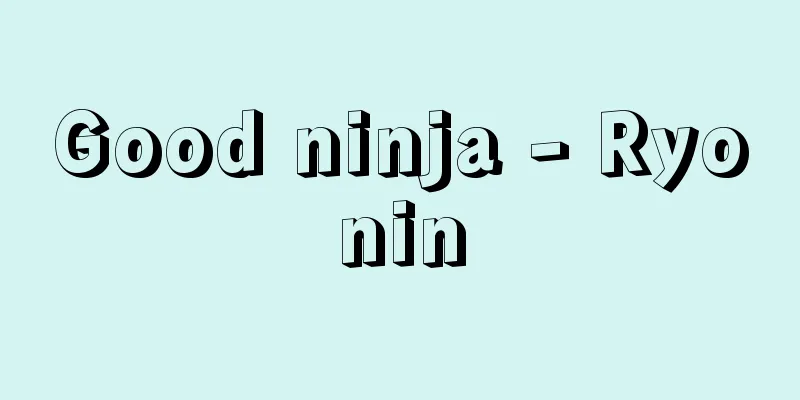Good ninja - Ryonin

|
Year of death: 1132 Year of birth: Enkyu 5 (1073) A Jodo Buddhist monk from the late Heian period and the founder of the Yuzu Nembutsu sect. He was the founder of the Tendai Ohara Gyozan Shomyo sect's revival. He was called Ryonin when he was young. His pen name was Kosei (no)bo. His posthumous name was Shoo Daishi. From the age of 20 to 31, he studied near the Toto Dannain Jitsubo sect on Mount Hiei, while also serving as a monk (a choir monk) who performed constant nembutsu at the Jyogyo Zammaido, which has Amida Buddha as its principal image. In later years, he retired to Ohara, and as a Bessho nembutsu saint, he recited a section of the Lotus Sutra and 60,000 nembutsu stanzas every day, and performed rituals at morning, noon, and sunset. At the same time, he separated nembutsu and sutra chanting (Shomyo), which has its own unique rhythm, from the Jyogyo Zammaido and made them independent, and established the Ohara Gyozan-ryu Shomyo sect as Buddhist music. Ryonin also had the side of a Shugendo ascetic and a private fundraising saint. Combined with the statue of Ryonin conducting a nembutsu choir, this made him regarded as the founder of Yuzu Nembutsu shortly after his death. According to the Yuzu Nembutsu Engi Emaki, produced in 1314 during the Kamakura period when the idea of Yuzu Nembutsu had been perfected and spread, when Ryonin was 46 years old, he received a revelation from Amida Buddha in a dream that one person's nembutsu will reach all, and the nembutsu of the many will reach one person, resulting in swift attainment of rebirth in the Pure Land, and that this is Yuzu Nembutsu through other power. Seven years later, in 1125, when Ryonin visited Kurama Temple for a wake, the principal image of Bishamonten appeared and announced that he would protect Yuzu Nembutsu, and presented him with a register showing that all the Buddhas, deities, and even those in the afterlife, including King Enma, from all over Japan, had been added to the Nembutsu swarm. With this tradition as a guarantee, from the 14th century onwards, the activities of Yuzu Nembutsu, which places more importance on the power of the Nembutsu of living beings than on the power of the original vow of Amida Buddha, became active. (Ueda Sachiko) Source: Asahi Japanese Historical Biography: Asahi Shimbun Publications Inc. About Asahi Japanese Historical Biography |
|
没年:長承1(1132) 生年:延久5(1073) 平安後期の浄土教の僧で融通念仏宗の開祖。天台大原魚山声明中興の祖。若年時に良仁と称した。号は光静(乗)房。諡は聖応大師。20歳から31歳ごろには,比叡山の東塔檀那院実報房近辺で勉学の一方,阿弥陀仏を本尊とする常行三昧堂で不断念仏を行じる堂僧(念仏合唱僧)を勤めた。後年大原に隠棲,別所の念仏聖として毎日法華経一部と念仏6万遍を誦し,朝・昼・日没に行法を行う生活に入った。そのかたわら常行三昧堂から念仏と独自の節づけを持つ読経(声明)を切り離して独立させ,仏教音楽として大原魚山流声明の一派を立てた。良忍にはまた修験的苦行者と民間勧進聖の側面があった。それが念仏合唱の指揮者良忍像と相まって,死後ほどなく融通念仏の始祖と目される。融通念仏の思想が完成して流布する鎌倉時代の正和3(1314)年製作の『融通念仏縁起絵巻』によると,良忍は46歳のとき,夢中に阿弥陀仏から,ひとりの念仏は衆人に,衆人の念仏はひとりに通じて速疾往生が成就する,これが他力の融通念仏であるとの啓示を得た。その7年後の天治2(1125)年,良忍が鞍馬寺に詣で通夜をしたとき,本尊毘沙門天が現れて融通念仏を守護すると告げ,日本国中の諸仏,神祇,閻魔王以下の冥途の衆までを念仏衆に加えたことを示す名帳を差し出したという。この伝承を保証として,14世紀以降,阿弥陀仏の本願力以上に衆生の念仏力を重視する融通念仏の活動が活発になる。<参考文献>融通念仏宗教学研究所編『良忍上人の研究』 (上田さち子) 出典 朝日日本歴史人物事典:(株)朝日新聞出版朝日日本歴史人物事典について 情報 |
<<: Liaoning Province - Liaoning
Recommend
Mawāli (English spelling)
The plural form of the Arabic word mawlā generally...
Kamui Uwepekere - Kamui Uwepekere
According to Mashiho Chiri, Tuitaku is a transfor...
McCarthyism
A series of crackdowns on Communists was carried o...
Jiraiya
Also written as Jiraiya. A phantom thief who appea...
Battle of Kawagoe Castle
A battle for Kawagoe Castle in Musashi Province to...
Flame Propagation
… Another type of ignition, ignition by a pilot f...
Shin Chae-ho
A Korean independence activist and historian who e...
Butzbach, J. ButzbachJ
…As sung in Carmina Burana, many of the wandering...
Post-Impressionism
The name comes from the exhibition "Manet and...
mousetail
…Perennial aquatic plant of the Equisetaceae fami...
Transformation rule
...A logical formula is a diagrammatic representa...
Man's Enemy
An American film produced in 1935. Original title:...
Konkai Komyoji Temple
This is the head temple of the Jodo sect of Buddh...
Adamantane
It is a stable hydrocarbon with a cage structure i...
Atsutada Odaka
Year of death: January 2, 1901 (Meiji 34) Year of ...





![Kiyosato [town] - Kiyosato](/upload/images/67cb5f5560b31.webp)



